110 results
Astronomy scaffolded notes for Microsoft Word
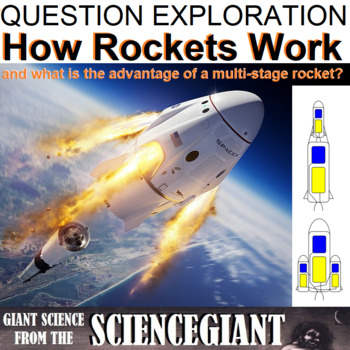
Question Exploration and Lab: How Do Rockets Work?
How Do Rockets Work? This Question Exploration helps Ss explain how Does a Rocket Work, and What is the Main Advantage of a Multi-stage Rocket?Question Exploration Routine is an instructional methods that teachers can use to help a diverse student population understand a body of content information by carefully answering a critical question to arrive at a main idea answer. Students taught using the Content Enhancement routines earned higher total test scores than did students taught using the le
Subjects:
Grades:
6th - 10th
NGSS:
HS-ETS1-2
, HS-ETS1-3
, MS-ETS1-1
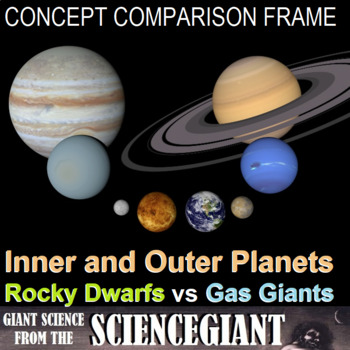
Concept Compare: The Inner and Outer Planets (rocky dwarf vs. gas giant)
How are the other planets of our solar system different from Earth? This Concept Comparison Frame helps students contrast the Inner and Outer Planets, with the terrestrial rocky dwarfs of Mercury, Venus, Earth and Mars on the one side, and jovian gas giants of Jupiter, Saturn, Uranus, and Neptune on the other. The Concept Comparison Routine is used help compare and contrast key concepts. Specifically, students use like and unlike characteristics and categories shared and not shared by two or mor
Subjects:
Grades:
6th - 12th
NGSS:
MS-ESS1-3
Also included in: StayGiant Earth Science Bundle: Astronomy (space exploration)

Concept Compare: Kepler's (and Newton's) Laws of Planetary Motion for Orbits
This concept comparison is between: Kepler's Laws of Planetary Motion, and how they relate to Newton's Laws of Motion and the Law of Universal Gravitation. Bring a calculator!The Concept Comparison Routine is used help compare and contrast key concepts. Specifically, students use like and unlike characteristics and categories shared and not shared by two or more concepts to better understand the overall concept. Students taught using the Content Enhancement routines earned higher total test scor
Subjects:
Grades:
7th - 12th, Higher Education
NGSS:
HS-ESS1-4
Also included in: StayGiant Earth Science Bundle: Astronomy (space exploration)
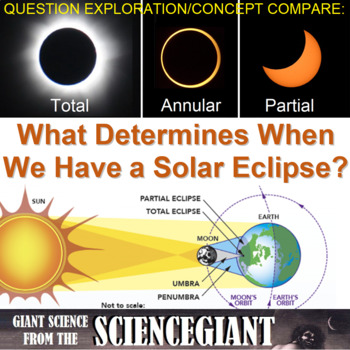
Concept Compare and Question Explore: Solar Eclipse on January 14, 2029
Why do eclipses happen? Why doesn't every new moon result in a solar eclipse? This question exploration helps students explain What determines when do we have a solar eclipse? It also includes: a concept comparison of three solar eclipses visible in the United States: a partial eclipse on Wednesday, January 26, 2028 and Sunday, January 14, 2029; an annular eclipse on Thursday, June 11, 2048; and a total solar eclipse of Wednesday, March 30, 2033 (only visible in Alaska. For the lower 48 states,
Subjects:
Grades:
7th - 10th
NGSS:
HS-ESS1-4
, MS-ESS1-1
Also included in: StayGiant Earth Science Bundle: Astronomy (space exploration)
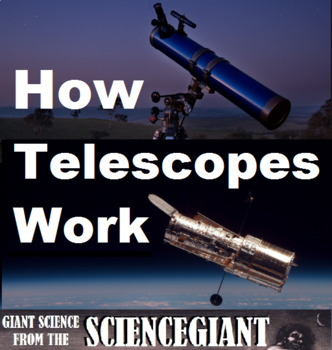
Concept Compare: Great Galileo! How Telescopes Work (refractor,reflector,radio)
What are telescopes and how do they work? This Question Exploration helps Ss explain how do different types of telescopes work. The Concept Comparison contrasts refracting, reflecting and radio telescopes. And there is a Frame reviewing the astronomical accomplishments of the first champion of telescopes -- Galileo Galilei. Magnifico!Framing Routines and Question Exploration Routines are instructional methods that teachers can use to help a diverse student population understand a body of content
Subjects:
Grades:
7th - 10th
NGSS:
HS-PS4-5
, MS-PS4-2
, HS-PS4-1
Also included in: StayGiant Physics Bundle: Optics

Total Solar Eclipse Explanation Guided Notes/Handout - Middle or High School
One of the most amazing astronomical relationships is that the sun and moon appear the same size in the sky, allowing for a spectacular total solar eclipse where the invisible new moon reveals itself and perfectly covers the sun in the mid-day sky. This can be explained to students mathematically in relatively simple terms, along with understanding the mechanics of how a solar eclipse comes to be though the use of this handout.This is a guided handout from my Astronomy Unit Plan (also available
Subjects:
Grades:
6th - 9th
CCSS:
NGSS:
MS-ESS1-3
, MS-ESS1-1

Question Exploration: What Causes Seasons and the Solstices?
What Causes Seasons and Solstices? This question exploration helps students explain how the Earth has seasons because its axis is tilted. Earth rotates on its axis as it orbits the Sun, but the axis always points in the same direction, creating a North Pole!The resource also includes reading excepts:"The Measure of Eratosthenes" by Carl Sagan. From the first episode of Cosmos, Sagan easily proved the Earth was a sphere using the summer solstice, the shadows of some sticks, a piece of cardboard,
Subjects:
Grades:
7th - 12th
NGSS:
HS-ESS2-4
, MS-ESS2-6
, MS-ESS1-1
Also included in: StayGiant Earth Science Bundle: Astronomy (space exploration)
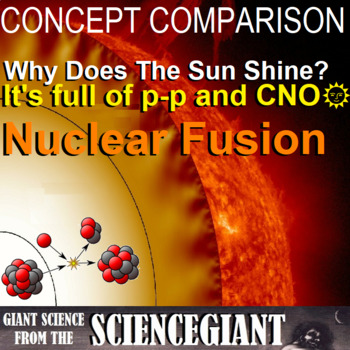
Concept Compare: Why Does the Sun Shine? Thermonuclear Fusion! (p-p and CNO)
This Concept Comparison of Thermonuclear Fusion contrasts proton-proton (p-p) chain reactions, and the "cold" carbon-nitrogen-oxygen (CNO) cycles. Help Ss communicate scientific ideas about the way stars produce elements over their life cycle. Emphasis is on the way nucleosynthesis, and therefore the different elements created, varies as a function of the mass of a star and the stage of its lifetime. As cosmologist Carl Sagan famously said, “We are made of star stuff.” And we literally are! We a
Subjects:
Grades:
8th - 12th, Higher Education
NGSS:
HS-PS1-8
, HS-ESS1-3
, HS-ESS1-1
Also included in: StayGiant Earth Science Bundle: Astronomy (space exploration)
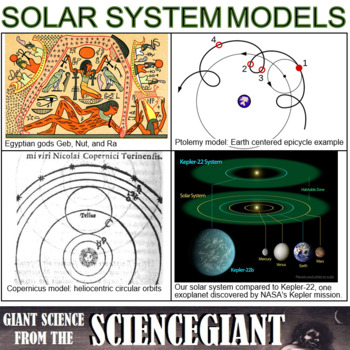
Concept Comparison and Question Exploration: Models of the Solar System
What are historical models of the solar system? This Question Exploration and Concept Comparison helps Ss contrast geocentric model painted in ancient temples, to heliocentric models photographed in modern telescopes. Question Exploration Routine is an instructional methods that teachers can use to help a diverse student population understand a body of content information by carefully answering a critical question to arrive at a main idea answer. Students taught using the question exploration r
Subjects:
Grades:
7th - 10th
NGSS:
HS-ESS1-4
, MS-PS2-4
, MS-ESS1-2
, HS-PS2-4
Also included in: StayGiant Earth Science Bundle: Astronomy (space exploration)

Phases of the Moon 5th Grade (Worksheet)
This worksheet is designed to help students retain information from the Moon Phases presentation posted on my storefront. This is meant to help them visualize phases of the Moon as well as the definitions related to each Moon phase.
Subjects:
Grades:
5th
Types:
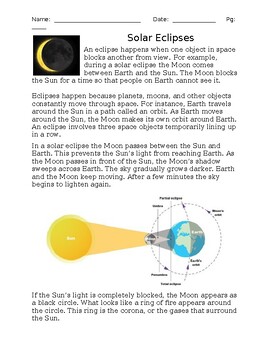
Read to Learn -Solar Eclipses - Introductory Earth Science and Astronomy
This reading introduces students to solar eclipses and mentions the total solar eclipse occurring on 8 April 2024. Students are provided short paragraphs about solar eclipses and are provided models to aid their understanding. Ample space is provided to allow students to interact with the text by circling / boxing / underlining key ideas. One suggestion for use is to provide students sticky notes to practice asking a question for each paragraph. The question should then be answered by readi
Subjects:
Grades:
5th - 8th
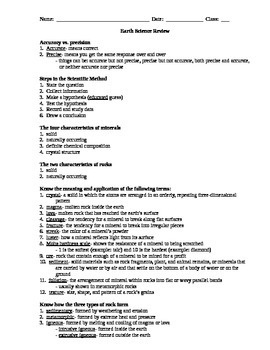
Earth Science final review sheet- geology, meteorology, hydrology, astronomy
INCLUDES THREE COPIES:
- Pages 1-11 are the answers
- Pages 12-22 are the outlines for students to fill in
- Pages 23-35 are a modified/shortened outline for students with disabilities
This is a compilation of all of the review sheets I use throughout the year (shortened a bit to leave just the bare bones needed to understand the standards). I follow the Georgia Performance Standards, 6th grade, science, which includes geology, hydrology, meteorology and astronomy.
Subjects:
Grades:
6th - 8th

Question Exploration: What Are the Solar Activity Sunspot Cycles?
What are the solar activity sunspot cycles? Sunspots increase and decrease through an average cycle of 11 years. This Question Exploration helps Ss explain how the spotless Sun turns dark, releasing solar flares and coronal mass ejections (CMEs).Question Exploration Routine is an instructional methods that teachers can use to help a diverse student population understand a body of content information by carefully answering a critical question to arrive at a main idea answer. The Concept Comparis
Subjects:
Grades:
7th - 12th, Higher Education
Types:
NGSS:
HS-ESS1-1
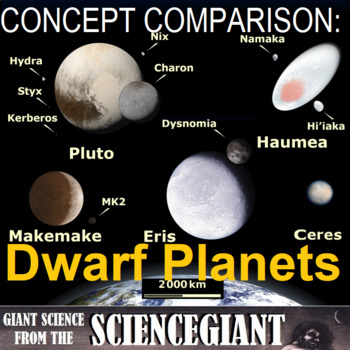
Concept Comparison: Dwarf Planets (Ceres, Pluto, Huamea, Eris, and Makemake)
This Concept Comparison Frame contrasts the dwarf planets CPHEM (Ceres, Pluto, Huamea, Eris, and Makemake). These round worlds orbit the Sun but didn't completely clear their neighborhood (one is in the asteroid belt and the rest are in the Kuiper Belt). It helps Ss explain how these rocky and icy minor planets are just as important to understanding the solar system as gas giants. The Concept Comparison Routine is used help compare and contrast key concepts. Specifically, students use like and u
Subjects:
Grades:
6th - 12th
NGSS:
HS-ESS1-4
, MS-ESS1-3
Also included in: StayGiant Earth Science Bundle: Astronomy (space exploration)
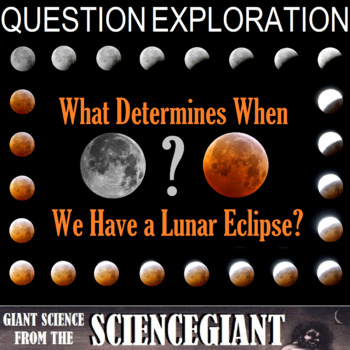
Concept Compare and Question Explore: Lunar Eclipse of 14 March 2025
Why doesn't every full moon result in a lunar eclipse? This question exploration helps Ss explain what determines when the Moon will be eclipsed, as on Friday, March 14, 2025 at 3 AM Eastern? Resource also includes a concept comparison of solar and lunar eclipses; and types of eclipses (total, partial, penumbral (lunar), and annular (solar). Actitivies and assessments for this resource include:a whole class formation activity to make a human model of a lunar eclipse, a math activity to make an u
Subjects:
Grades:
5th - 12th
NGSS:
HS-ESS1-4
, MS-ESS1-1
Also included in: StayGiant Earth Science Bundle: Astronomy (space exploration)
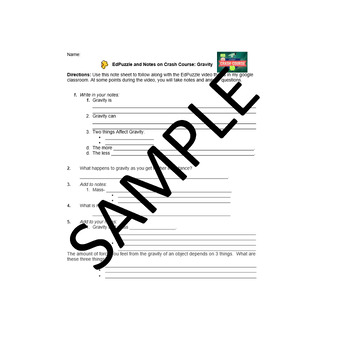
Crash Course Gravity EdPuzzle Note Sheet
· This note sheet is great to use as a warm-up, quick notes, or self-paced with a substitute. · This note sheet only covers the first 4 minutes of the Crash Course Gravity Video. After that point he gets more advanced than my 7th grade students need. Here is the link to my EdPuzzle Lesson that goes with these notes. The EdPuzzle will prompt them to write notes and fill in answers to the questions as they watch.
Subjects:
Grades:
6th - 8th
Types:
NGSS:
MS-ESS1-2

Question Explore: What Methods Measure Ultra Space Deep Distances? Parallax
This Question Exploration asks the Essential Question about cosmic distances: What Methods Do Astronomers Use to Measure Ultra Deep Space Distances? (from radar and parallax, to standard candles and Tully-Fisher Relationship used to measure distances to galaxies).Included are two activities on the scale of the universe for student assessment to be used as a warm up or after class review. The first is a classroom formation line-up, the other is a two-inch universe modeling about scale and ratios.
Subjects:
Grades:
7th - 11th, Higher Education
NGSS:
5-ESS1-1
, MS-ESS1-2
Also included in: StayGiant Earth Science Bundle: Astronomy (space exploration)
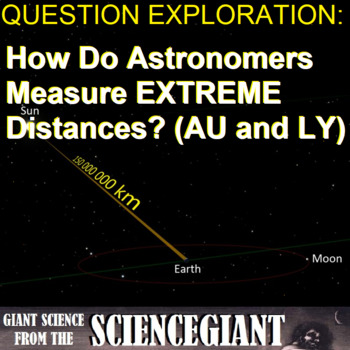
Question Exploration: How Do Astronomers Measure Extreme Distances? (AU and LY)
This Question Exploration asks the Essential Question about cosmic distances: How Do Astronomers Measure Extreme Distances? (astronomical units and light years )Question Exploration Routine is an instructional methods that teachers can use to help a diverse student population understand a body of content information by carefully answering a critical question to arrive at a main idea answer. Students taught using the question exploration routine earned higher total test scores than did students t
Subjects:
Grades:
7th - 10th
Also included in: StayGiant Earth Science Bundle: Astronomy (space exploration)
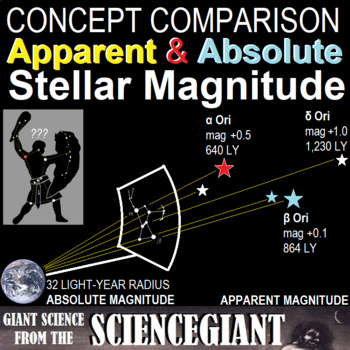
Concept Comparison: Apparent vs. Absolute Magnitude of Star Brightness
What is the stellar magnitude scale? This Concept Comparison helps Ss contrast apparent magnitude and absolute magnitude. The Question Exploration guides Ss to an explanation of why star light isn't always star bright. Included are three mathematics worksheet and one optional art activity from NASAThe Stellar Magnitude Scale: Ss learn about positive and negative numbers using a popular brightness scale used by astronomers.Star Magnitudes and Decimals: Ss work with the stellar magnitude scale to
Subjects:
Grades:
8th - 12th
NGSS:
HS-ESS1-4
, HS-ESS1-2
Also included in: StayGiant Earth Science Bundle: Astronomy (space exploration)

Question Exploration: What Determines the Life Span of a Star?
When Will the Sun Burn Out? Will the Sun ever blow up and kill us all? This Question Exploration helps Ss answer the Essential Question: What Determines the Life Span of a Star like the Sun?Question Exploration Routine is an instructional methods that teachers can use to help a diverse student population understand a body of content information by carefully answering a critical question to arrive at a main idea answer. The Concept Comparison Routine is used help compare and contrast key concepts
Subjects:
Grades:
7th - 10th
NGSS:
MS-ESS1-4
, HS-ESS1-3
, HS-ESS1-1
Also included in: StayGiant Earth Science Bundle: Astronomy (space exploration)

Question Exploration: What Was the Space Race? (Rocket Rivals Russia and USA)
What Was the Space Race? This Question Exploration helps Ss explain What are key events, developments and achievements in the early history of space exploration during the rocket rivalry between Russia and America? It spans from October in 1957 with the launch of first satellite Sputnik 1, to the International Space Station today.Question Exploration Routine is an instructional methods that teachers can use to help a diverse student population understand a body of content information by carefull
Subjects:
Grades:
7th - 11th
NGSS:
HS-ETS1-3
, HS-ETS1-1
Also included in: StayGiant Earth Science Bundle: Astronomy (space exploration)

Crash Course Video Questions: The Sun
These are questions based on the Crash Course Astronomy Video titled "The Sun: Crash Course Astronomy #10" Topics covered are the suns layers, nuclear fusion, plasma, sunspots, solar flares, and auroras. A great review or introductory tool to the Sun, sunspots, solar flares,and auroras.
Subjects:
Grades:
8th - 12th
Types:
NGSS:
HS-ESS1-1
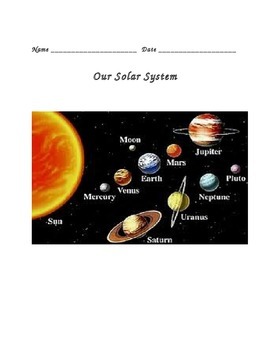
Solar System & Beyond Notes 4th Grade Science
6 Lessons
1. Planets
The Sun, stars, Planets, orbit, closest and farthest from the sun, Mercury, Venus, Earth, Mars, Jupiter, Saturn, Uranus and Neptune, inner and outer planets, moons, asteroids
The order from smallest to largest is Mercury, Mars, Venus, Earth, Neptune, Uranus, Saturn, and Jupiter. Earth is the largest of the rocky inner planets.
Dwarf Planets, Ceres, telescope, The Hubble Space Telescope, Space probes , Phoenix Mars Lander, scientific instruments, Mars Exploration Rover,
Subjects:
Grades:
4th

FRAME: McElligot's Pool and The Drake Equation - Search for SETI with Dr. Seuss
Because you never can tell what goes on down belowThis pool might be deeper than you or I know!McElligot's Pool and the Drake Equation uses the fanciful imagination of Dr. Seuss and the fish in McElligot's Pool to engage Ss in the extraordinary topics of alien life and space exploration. Marco daydreams of all the possibilities that await him while he fishes in McElligot’s Pool. After a read-aloud of an abridged McElligot’s Pool, the frame routine helps Ss explain how the Drake Equation is a tho
Subjects:
Grades:
6th - 11th
NGSS:
HS-ESS1-6
, HS-PS4-5
, HS-ESS2-7
Also included in: StayGiant Earth Science Bundle: Astronomy (space exploration)
Showing 1-24 of 110 results





